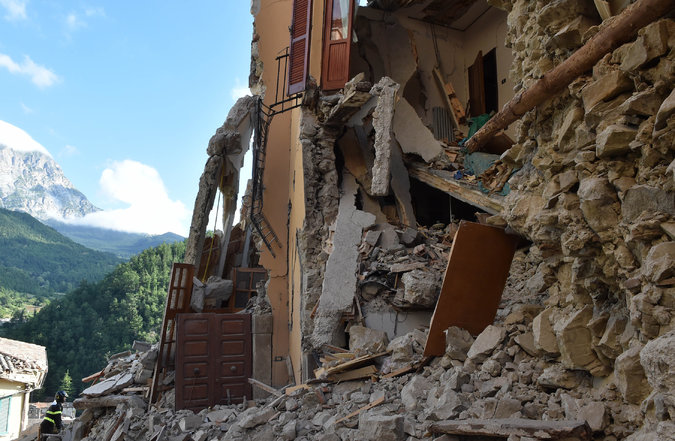Milan — If you put a pin right in the middle of a map of Italy, you’re likely to hit Amatrice. A small, historic city known as “the town of the hundred churches,” it lies two hours from Rome and 3,280 feet above sea level, in the scenic Gran Sasso National Park, on the watershed between the Adriatic and the Tyrrhenian Seas. The area straddles four of our most famous regions: Lazio, Abruzzo, Marche and Umbria. Amatrice is the centerpiece of picture-postcard Italy, for those who find Tuscany too obvious, Rome too noisy and Venice too crowded.
And in the space of just one summer’s night, Amatrice is all but gone.
So are the nearby villages of Accumoli and Pescara del Tronto, wiped out by a 6.2 magnitude earthquake that struck central Italy early Wednesday, killing at least 241 people, including children, trapping scores more under debris, leaving thousands homeless and setting off tremors that were felt from Bologna to Naples.
Today, according to one witness, “The area looks like Dante’s Inferno.” But until yesterday it looked like paradise. A lovely corner of the country. Ancient, unspoiled hilltop villages — for many foreigners, the quintessence of their Italian fantasies. For us Italians, a source of pride.

A view of damaged homes by an earthquake in Arquata del Tronto, Italy on Wednesday. Credit Giuseppe Bellini/Getty Images
The quake struck Amatrice and the surrounding area at 3:36 a.m. — amazingly, almost the exact same time as the one that devastated L’Aquila and Abruzzi in 2009, which killed over 300. Some of the dead, this time, were tourists. Travelers go to Amatrice in August for the mild climate, an evening stroll and spaghetti all’amatriciana — a dish famous all over the world, invented by local shepherds in the Middle Ages.
This week, the town was getting ready for the 50th annual festival dedicated to the celebrated sauce. Luckily, most visitors had left for the night. But the Hotel Roma had 70 guests, and at the time of writing they are unaccounted for.
We all forget — visitors and residents alike — that Italy is a stunning but shaky land. Since 1861, when the country was unified, there have been 35 major earthquakes and 86 smaller ones. Every region has been hit. Over 70,000 people lost their lives in an earthquake that struck Messina, Sicily, in 1908. The island was hit again in 1968; Friuli in 1976, Campania in 1980, Abruzzo in 2009, Emilia in 2012. The Apennine mountain range, the geological spine of Italy, has been repeatedly battered.
Italy’s beauty is fragile. Ancient buildings are gorgeous but can be dangerous. Its cities are old and dense, and its buildings rendered vulnerable by heritage laws that protect them from modernization, for better and worse. Carmine Galasso, a lecturer in earthquake engineering at University College London, told Time magazine: “The challenge is really to assess the seismic safety of existing old buildings and prioritize interventions for retrofitting and strengthening.”
That takes time and costs money, though. And while Italy is a modern, wealthy country, many parts of the country are poor, its residents unable to shoulder the costs. Corrado Longa, an architect who lives in Spelonga, near Arquata del Tronto, in the area hit by the quake, told Corriere della Sera: “The owners are old and live alone, and they don’t have the resources. Or because they are considered just holiday homes, and people don’t care.” When disaster strikes, lack of resources and Italy’s cumbersome bureaucracy make it difficult to rebuild. Seven years and $13.5 billion were not enough to bring L’Aquila’s vast historic downtown back to life.
That’s not to say Italy is ignorant of the problem. It has one of the world’s most advanced building codes for new construction. Unfortunately, it is not always followed — as the 2009 earthquake in Abruzzo painfully proved.
Earthquakes are not the only threat to Italian beauty. Floods and landslides have become more frequent and destructive, since small farmers stopped tending the hillsides and unscrupulous real estate developers replaced them. Small, winding mountain roads — the umbilical cords of little communities across the country — are expensive to maintain, and some local authorities don’t even try. Depopulation has done the rest. Amatrice had already lost three-quarters of its inhabitants in a century — going from 10,000 to just 2,500. They emigrated, they went to Rome and other cities to find work.
Italy is not always charming and picturesque. It’s an ancient and vulnerable place. It needs maintenance, respect and resources. But even those may not be enough, as poor Amatrice knows too well.
This article has been updated to reflect news developments.

